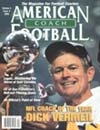AMERICAN FOOTBALL MONTHLY THE #1 RESOURCE FOR FOOTBALL COACHES
Article CategoriesAFM Magazine
|
Rolling to Victoryby: Michael C. Parodi,Quarterback Coach, and the City College of San Francisco Coaching Staff © More from this issue The 1999 season was very successful for the players, coaches and staff of City College of San Francisco. We were fortunate enough to complete our season with a perfect 12-0 record and win the 1999 J.C. Gridwire National Championship and California state championship. We also achieved this same feat in 1994 after completing the season 11-0. In the 90s, we won our conference nine times in 10 years (1990, 1992-1999) and we are three-time defending Northern California champions. In all, we ended the decade with a record of 102-11. Offensively, we have averaged 490 yards per game over the last 10 years and usually finish among the nation's top 5 in total offense. As a staff, we know that we must work hard and put in many hours to succeed. We expect nothing less from our student-athletes. We are very proud of our success and plan to conti....The full article can only be seen by subscribers.
|
|
|||||||
| HOME |
MAGAZINE |
SUBSCRIBE | ONLINE COLUMNISTS | COACHING VIDEOS |
Copyright 2025, AmericanFootballMonthly.com
All Rights Reserved





